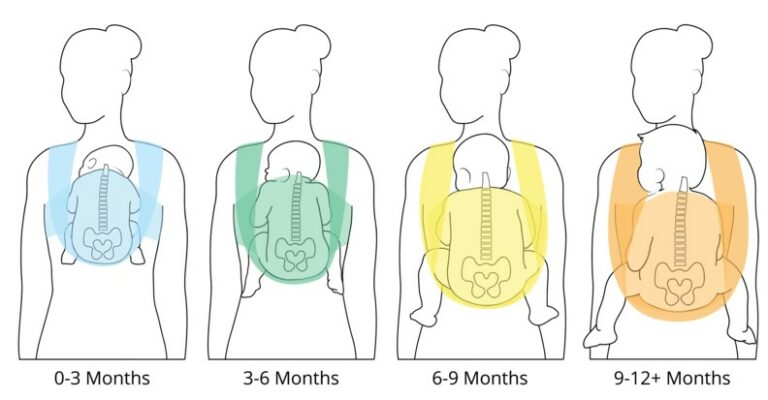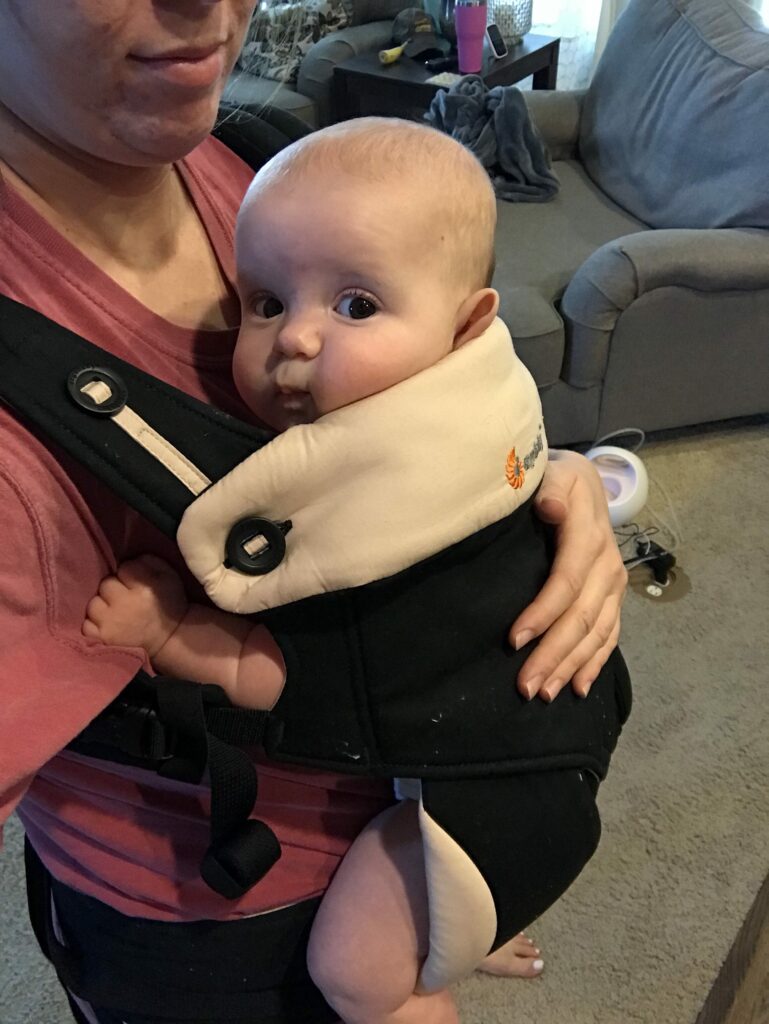Baby-wearing is a popular trend and can certainly come in handy for a baby that loves to be snuggled or for mamas who have other kids running around. It is also a wonderful alternative to tummy time and a position to use to help prevent Flat Head Syndrome. But, there are SOOOOO many different carriers on the market. How in the world do you know which one to choose? Some of the decision comes down to personal preference, but there are some important details to consider as well.

How does baby’s development play into choosing a carrier?
First, let’s take a small detour to get a quick baby anatomy lesson! I want to mention three important characteristics of your newborn/infant’s anatomy that will help you decide the best carrier: the fetal position, the hip joint and the spine.
- The fetal position: This is a term used to describe how most babies enter this world – with their arms and legs curled in close to their body. When a baby is first born, they have what we call hip and knee “contractures,” meaning that their hips and knees do not fully straighten. Within the first month, baby’s arms and legs will begin to straighten as she begins to explore her new freedom outside the womb and stretch her arms and legs.
- Hip joints: A newborn’s hip sockets are very shallow and the ligaments around the hip are very lax. All of this means that your baby’s hip joint is very unstable and very delicate. Weight bearing (crawling, standing and walking) help to form a deeper socket and create a more stable joint. But, until your baby is ready for those things, keeping the legs in a “frogged” position will help protect the hip joint from dislocation and decrease the risk for hip dysplasia.
- Spine: An adult spine has 4 distinct curves – one near the neck, one near the middle of the back, one at the low back near the pelvis and one ending at the tailbone. But, your newborn’s spine is shaped more like a giant “C” and is basically one big curve (remember the curled up fetal position). Things like learning to lift the head in tummy time, learning to sit and crawling on hands/knees help to develop the mature curves of the spine.

What should you look for when choosing a carrier?
When we are choosing a baby-wearing carrier, we want to take all of the above anatomical factors into consideration. We also want to take mom’s (or other caregiver’s) body/posture into consideration as well. You need a strong, healthy body to keep up with this little one for the next 18+ years, so we want to protect your back, shoulders, and hips, too! Here are some important things to look for in a carrier:
- Does it fully support your baby’s head? Even when your baby has decent head control at a few months old, her neck/head are still susceptible to your body movements while you’re walking down the street, turning abruptly or bending over to pick something up. Until babies are working on crawling skills, their head should be well supported by the carrier.
- Does the carrier hold your baby’s legs in an “M” position? Here’s a good way to think of it: is your baby’s bottom lower than her knees and are her knees pointed out in a “frog” position?
- Does the carrier provide good ergonomic support to keep mom or dad’s shoulders and back protected? Thick straps and carriers that hold baby up high on your torso will provide the best biomechanical support for caregivers.
So, what are my recommendations?
I have taken all of these things into consideration when choosing my favorite carriers. I am including carriers from two different categories: one for newborns and small infants and one that is more versatile for larger babies/toddlers as well.
Without further ado, my recommendations for the BEST BABY CARRIERS are……drum roll please…..
For newborns and small infants, I recommend the K’tan Wrap:
- I like the K’tan wrap because it doesn’t have any buckles, straps or adjustments. It is sized like clothing for a snug fit to keep baby high and close to you. You can also choose 5 different positions to carry your baby. Technically, you can use this wrap until your baby is 35 pounds, but I found that after the first few months, it was too hard to get baby in/out of easily. The biggest downside to this wrap, in my opinion, is that they are sized like clothes, so you cannot switch these between caregivers unless you are the same size.
- Some similar wraps include: Ergobaby Aura Baby Wrap, Moby wrap, and the Boba wrap. I have not used any of these and do not have personal experience to their comfort or ease of use, but they all offer similar features.
For larger babies and toddler, I recommend the Ergo 360:
- I love this carrier because it is easy to adjust between different caregivers. It is also very supportive of baby and comfortable for the caregiver, but it is also breathable! As the name implies, you can wear this a multitude of ways: carrier in front with baby forward or inward facing and carrier in the back with baby inward facing. It has thick straps on the shoulders and waist and I have never been uncomfortable when baby-wearing with this carrier. One downfall of this carrier in my opinion is that you cannot use it for newborn and toddler phases as is. You either need a separate insert for a newborn (up to 12 pounds) or you need a separate carrier for the newborn stage. A second downfall is that you need good shoulder flexibility to reach behind your head and strap your baby in on your own. But, overall, this carrier is a great choice for you if you want to baby wear for an extended amount of time!
Since I only recommend things I have used and loved, this is why I recommend the K’tan wrap and the Ergo 360 carrier. There are many other options out there that are probably just as great as these two recommendations. When you are searching for the perfect wrap or carrier to put on your registry, do your homework using the guidelines outlined above regarding your baby’s posture and your own ergonomic comfort!

Be the first to comment